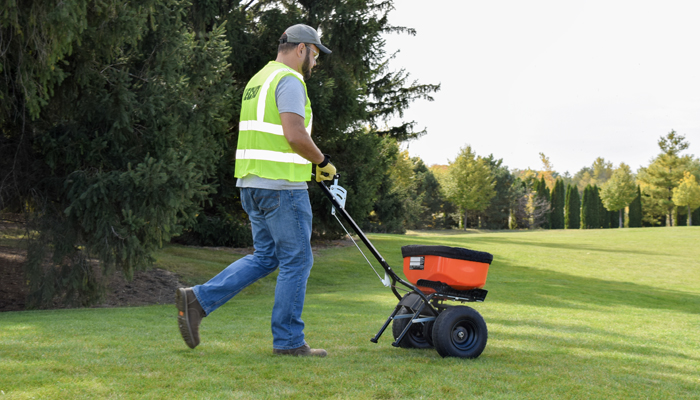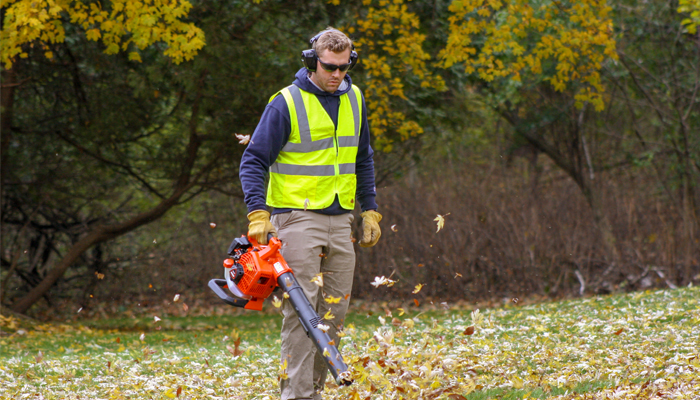All-Season Lawn Care Schedule
Keeping your lawn vibrant and healthy all year requires consistent care and attention. The effort pays off when you have a beautiful, resilient yard every season. A do-it-yourself lawn care schedule includes essential tasks and best practices for each season, so your lawn will thrive from the cold of winter through the heat of summer.
With a proper all-season lawn maintenance schedule, you’ll know how to take care of your lawn year-round, so your yard will be the envy of the neighborhood.
Spring Lawn Care
By spring, you’re probably more than ready to ditch those dark, cold winter days and get back out in the yard. Spring is critical for rejuvenating your lawn while the temperatures warm up and the days grow longer.
Lawns go dormant throughout winter. As they wake up, having an effective lawn treatment schedule will encourage a healthy lawn that can withstand the daunting heat of summer. The right preparation will last throughout the growing season, spark new growth, and prevent weeds.
Lawn Preparation
The first step in a spring lawn care plan is removing debris, leaves, sticks, and dead grass to prevent disease and let your lawn begin to breathe. Rake the lawn to loosen the soil surface and promote air circulation, and then aerate it to allow air, water, and nutrients to penetrate grass roots.
Seeding & Fertilizing
After aerating, you’re ready to seed and fertilize. A combined approach of overseeding, fertilizing, and weed control produces the vibrant green grass you want.
Overseeding is a simple process of spreading grass seed to fill bare spots and improve lawn density. Choose a seed consistent with your current grass and use a high-quality spreader for even results.
Applying a balanced fertilizer in the spring will ensure your lawn has essential nutrients that promote healthy growth and strong root development.
You can also use a pre-emergent weed control product to keep weed seeds from germinating and taking hold, where they’ll compete for light, water, and nutrients.

Summer Lawn Care
Depending on where you live, summer heat can be brutal on your yard. Hot, dry weather can stress lawns, requiring careful attention and proper care to maintain vitality. To protect it, focus on watering, mowing, and pest and weed control.
Watering
Watering will be an essential part of your lawn treatment schedule during the summer. Deep watering promotes solid root growth and involves regularly soaking the soil 6 - 8”. It’s best to water during the coolest parts of the day to prevent evaporation – early morning or late evening are good. If you have one, an irrigation system ensures consistent moisture levels and that water is evenly delivered across the lawn.
Mowing
Proper mowing is key to keeping your lawn healthy in the summer. The trick is to mow high and leave the grass a bit longer – about 3” - 4” – to shade the soil, retain moisture, and reduce weed growth. How often you mow depends on how fast your lawn grows.
One of the most important parts of mowing is blade sharpness. Dull blades tear your grass, resulting in brown tips and disease susceptibility.
Pest & Weed Control
Controlling pests and weeds is a vital part of a summer lawn maintenance schedule. Being diligent in this area prevents annoying pest and weed issues from spreading or damaging your lawn.
Regularly inspect your lawn for signs of pest activity. Look for chewed grass blades, bare spots, or patches of dead grass. Treat any infestations immediately using natural pest control products or insecticides.
Post-emergent herbicides can target existing weeds for weed management without harming your grass.
Fall Lawn Care
As the summer heat begins to fade and the days grow crisp, it’s the perfect time to adjust your lawn care plan and prepare for the cold winter months ahead. Several essential steps in fall lawn care ensure your grass will be healthy and strong enough to endure the cold of winter and is ready to thrive when spring returns.
Learn everything you need to know about fall yard prep with: Fall Clean-up Essentials.
Aerating and Seeding
Aeration is once again a crucial part of seasonal lawn care during the fall. It helps alleviate soil compaction so air, water, and nutrients can penetrate the grass roots. Aerating your yard promotes healthy grass root development and can improve the overall resilience of your lawn.
Overseeding: After aerating, overseeding your lawn will thicken it, filling in bare or thin spots. Fall overseeding leads to a denser yard during the winter months.
Fertilize: Fertilizing during fall helps strengthen roots and provides essential nutrients that help your lawn survive winter.
Leaf Cleanup
Timely leaf cleanup is critical in the fall. Fallen leaves can suffocate your grass by blocking sunlight and trapping moisture, leading to mildew, mold, and disease. A blower can make the task more effective, fast, and manageable for larger areas. Small areas may only need raking.

Pest and Disease Control
Fall is the ideal time to inspect for lawn pests and disease. Monitoring regularly ensures you can catch and treat issues early to prevent further damage so they don’t carry over into the next growing season.
Pest infestation: Treat with insecticides or us natural remedies
Fungal disease: Apply fungicides
Winter Lawn Care
Although it can be tempting to see the winter months as “time off” in your yard, year round lawn care is important. Winter is the perfect time to make sure you’re ready for the upcoming spring and summer months. A proper lawn maintenance schedule protects grass during the cooler months but doesn’t require as much active maintenance – you can use this time for tool maintenance so your equipment is ready for action when spring arrives.
Lawn Protection
During winter, minimize foot traffic, which can compact soil and damage dormant grass. Carefully clear snow and ice build-up that can smother grass, and remove fallen branches or debris. These small steps can protect your grass and keep it resilient throughout winter.
Tool Maintenance
Use winter’s downtime to clean outdoor equipment and tools before storing them. After thoroughly cleaning tools, dry them completely to prevent rust and corrosion.
Perform maintenance like:
- Sharpening blades
- Changing oil
- Checking spark plugs
- Inspecting for repairs
- Replacing any worn or damaged parts
Planning for Spring
If you live in an area prone to frost, take the time just after fall – before the ground freezes – to conduct soil tests and check for nutrient needs and pH levels so you can plan your fertilization strategy.
Other tips on planning for spring:
- Plan any new tool purchases or upgrades
- Schedule spring lawn care tasks
- Late winter can be the ideal time for many pruning activities, preparing plants for healthy growth in the spring .

Year-Round Lawn Care is Easy with ECHO
Year-round lawn care is vital for keeping your yard healthy and beautiful throughout the year. Every season brings challenges and opportunities, and knowing which tasks are best throughout the year helps ensure the vitality and health of your lawn.
Regular maintenance, using the right tools and equipment, and knowing when and what interventions to use are crucial for a thriving yard. By following the right seasonal tips, you’ll be ready to address your lawn’s needs throughout the year.
With dedication and the right approach, your yard will be the envy of the neighborhood. Check out ECHO’s tools and outdoor equipment.